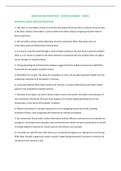SENSATION AND PERCEPTION – CHAPTER SUMMARY – EXAM 2
CHAPTER 8: VISUAL MOTION PERCEPTION
1. Like color or orientation, motion is a primary perceptual dimension that is coded at various levels
in the brain. Motion information is used to determine where objects are going and when they’re
likely to get there.
2. We can build a simple motion-detecting circuit by using linear filters that delay and sum
information (and are followed by nonlinearities).
3. V1 neurons view the world through a small window, leading to the well-known aperture problem
(that is, a V1 neuron is unable to tell which elements correspond with one another when an object
moves through its receptive field).
4. Strong physiological and behavioral evidence suggests that the middle temporal area (MT/V5) is
involved in the perception of global motion.
5. Aftereffects for motion, like those for orientation or color, can provide important insights into the
underlying mechanisms of perception in humans.
6. Luminance-defined (first-order) motion and contrast- or texture-defined (second-order) motion
appear to be analyzed by separate systems.
7. The brain has to figure out which retinal motion arises in the world, and which arises because of
eye movements. Moreover, the brain must suppress the motion signals generated by our eye
movements, or the world will be pretty “smeared.”
8. Motion information is critically important to us for navigating around our world, avoiding
imminent collision, and recognizing the movement of animals and people.
9. Eye movements that provide motion information include reflexive movements such as optokinetic
nystagmus; involuntary microsaccades; and movements over which we have varying levels of control,
including vergence movements, smooth-pursuit movements, and saccades.
10. Saccades are rapid-fire eye shifts that occur constantly throughout our waking hours and during
REM sleep. Saccadic suppression masks saccadic images being processed in the brain so that we do
not perceive the world as a blur.
, CHAPTER 9: HEARING – PHYSIOLOGY AND PSYCHOACOUSTICS
1. Sounds are fluctuations of pressure. Sound waves are defined by the frequency, intensity
(amplitude), and phase of fluctuations. Sound frequency and intensity correspond to our perceptions
of pitch and loudness, respectively.
2. Sound is funneled into the ear by the outer ear, made more intense by the middle ear, and
transformed into neural signals by the inner ear.
3. In the inner ear, cilia on the tops of inner hair cells pivot in response to pressure fluctuations in
ways that provide information about frequency and intensity to the auditory nerve and the brain.
Auditory nerve fibers convey information through both the rate and the timing patterns with which
they fire.
4. Different characteristics of sounds are processed at multiple places in the brainstem before
information reaches the cortex. Information from both ears is brought together very early in the
chain of processing. At each stage of auditory processing, including primary auditory cortex, neurons
are organized in relation to the frequencies of sounds (tonotopically).
5. Humans and other mammals can hear sounds across an enormous range of intensities. Not all
sound frequencies are heard as being equally loud, however. Hearing across such a wide range of
intensities is accomplished by the use of many auditory neurons. Different neurons respond to
different levels of intensity. In addition, more neurons overall respond when sounds are more
intense.
6. Series of channels (or filters) process sounds within bands of frequency. Depending on frequency,
these channels vary in how wide (many frequencies) or narrow they are. Consequently, it is easier to
detect differences between some frequencies than between others. When energy from multiple
frequencies is present, lower-frequency energy makes it relatively more difficult to hear higher
frequencies.
7. Hearing loss is caused by damage to the bones of the middle ear, to hair cells in the cochlea, to
neurons in the auditory nerve, or to the stria vascularis that provides nourishment and ions to the
hair cells. Although hearing aids are helpful to listeners with hearing impairment, there is only so
much that can be done to help when damage to hair cells cannot be repaired.
CHAPTER 10: HEARING IN THE ENVIRONMENT
1. Listeners use small differences, in time and intensity, across the two ears to learn the direction in
the horizontal plane (azimuth) from which a sound comes.





